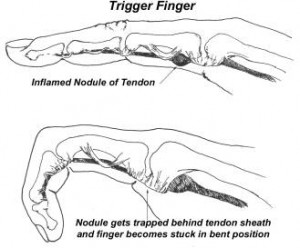Page Contents
Trigger Finger Pain
You’re not the only one suffering !
The first thing to realize about trigger finger pain is that the occurrence of trigger finger is far greater than many people imagine.
It’s a condition that affects the tendons of your fingers or thumb and limits movement. For example, when you try to straighten your finger, it will lock or catch before popping out straight.
 The medical name for this trigger finger pain condition is stenosing tenosynovitis. Stenosing refers to the narrowing of an opening or passageway in the body.
The medical name for this trigger finger pain condition is stenosing tenosynovitis. Stenosing refers to the narrowing of an opening or passageway in the body.
Tenosynovitis refers to inflammation of the outer covering of the tendons that bend and extend the fingers and thumb.
Stenosing tenosynovitis or trigger finger is much more common in women, with a frequency 2-6 times than that observed in men.
It’s been found that the peak incidence of trigger finger occurs in individuals aged between 55 and 60 years of age. Age distribution has not changed significantly despite an increase in computing activities and repetitive tasks.
What’s it like to live with trigger finger pain ? The risks and benefits of non-surgical treatment options versus surgery.
When the tendon catches when you have trigger finger, it produces inflammation and more swelling.This causes a vicious cycle of triggering, inflammation, and swelling and. sometimes the trigger finger becomes stuck or locked, and is hard to straighten or bend.
Increased incidence in the dominant hand is observed with trigger finger and, the involvement of several fingers is not unusual. The most commonly affected digit is the thumb, followed by the ring, long, little, and index fingers.
Triggering can happen at all ages from less that 5 years of age to greater than 80. However, this trigger finger condition most often occurs in people over 40 years of age. Sometimes triggering can follow a recent change in activities or work habits. At other times trigger finger may follow an injury or surgery in the arm or hand. However, in the vast majority of trigger finger cases, there is no clear reason for trigger finger to start.
The way the tendons work when you have trigger finger pain
Tendons are tissues that connect muscles to bone. When muscles contract, tendons pull on bones. This is what causes some parts of the body to move. The muscles that move the fingers and thumb are located in the forearm, above the wrist. Long tendons – called the flexor tendons – extend from the muscles through the wrist and attach to the small bones of the fingers and thumb.
These flexor tendons control the movements of the fingers and thumb. When you bend or straighten your finger, the flexor tendon slides through a snug tunnel called the tendon sheath, that keeps the tendon in place next to the bones.
They’re like long ropes connecting the muscles of the forearm with the bones of the fingers and thumb. In the finger, the pulleys are a series of rings that form a tunnel, through which the tendons must glide, much like the guides on a fishing rod through which the line (or tendon) must pass. These pulleys hold the tendons close against the bone. The tendons and the tunnel have a slick lining that allows easy gliding of the tendon through the pulleys
The flexor tendon can become irritated as it slides through the tendon sheath tunnel. As the trigger finger becomes more and more irritated, the tendon may thicken and nodules may form, making its passage through the tunnel more difficult.
Trigger finger or thumb occurs when the pulley at the base of the finger becomes too thick and constricting around the tendon, making it hard for the tendon to move freely through the pulley.
Sometimes the tendon develops a nodule (a knot) or swelling of its lining. Because of the increased resistance to the gliding of the tendon through the pulley, one may feel pain, popping, or a catching feeling in the trigger finger or thumb.
Trigger Finger Pain – Symptoms and Causes
Best Selling Trigger Finger Splints on Amazon
==>Don’t allow your trigger finger pain to go untreated – Click HERE<==
As an Amazon Affiliate we earn from qualifying purchases.TriggerFingerSymptoms.com is a participant in the Amazon Services LLC Associates Program, an affiliate advertising program designed to provide a means for sites to earn advertising fees by advertising and linking to Amazon.com,
Links on this trigger finger pain page are sponsored affiliate links and the owner makes commission if you buy after clicking these links. The owner is not a bona-fide user of a trigger finger pain relief product. However, he has thoroughly researched it and provided a personal opinion only. This disclosure is in accordance with the Federal Trade Commission’s 16 CFR, Part 255: “Guides Concerning the Use of Endorsements and Testimonials in Advertising.”
Tagged with: stenosing tenosynovitis • stenosing tenosynovitis treatment • trigger finger thumb • what is trigger finger
Filed under: Trigger finger


